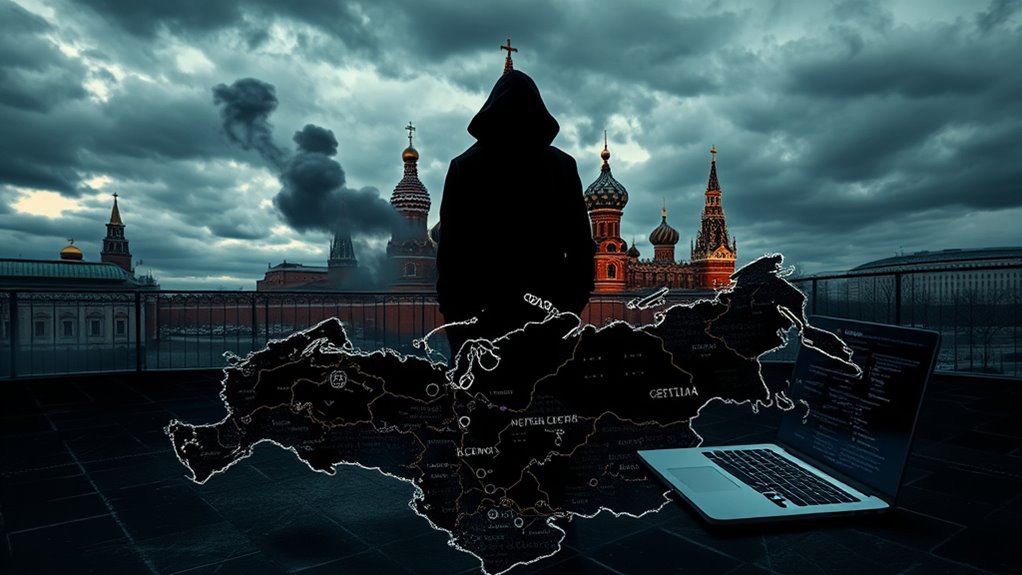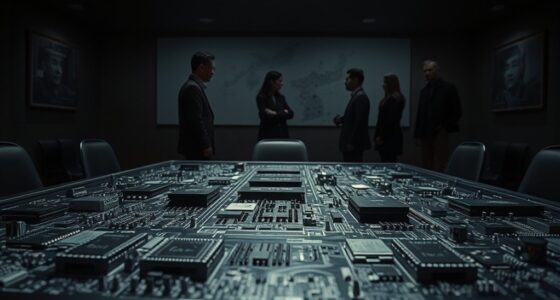Russia’s 2025 gambit is all about leveraging chaos and forming new strategic alliances to reshape its influence in a multipolar world. By embracing instability, Russia aims to challenge U.S. dominance while securing partnerships with key players like Iran and Turkey. Sanctions and military interventions elsewhere add layers of complexity to this approach. You’ll discover more about how these strategies unfold and their implications for global dynamics as you explore further.
Key Takeaways
- Russia aims for a multipolar world by fostering alliances, particularly in the Global South, amidst growing geopolitical chaos.
- The Kremlin’s reliance on instability may reflect a strategic shift to maintain influence without traditional forms of recognition.
- Military interventions, such as in Syria, underscore Russia’s position as a stabilizing force, despite facing recruitment challenges.
- Economic sanctions and declining energy exports hinder Russia’s long-term strategic planning, impacting its global influence.
- Hybrid warfare tactics and espionage highlight Russia’s adaptive strategies in an increasingly chaotic international landscape by 2025.
Russia’s Strategic Imperatives and Global Ambitions

As Russia endeavors to maintain its status as an influential player in global affairs, it actively seeks strategic partnerships, especially in the Middle East and the Global South.
These efforts align with its strategic imperatives and global ambitions to position itself as a key actor in a multipolar world. The Kremlin’s foreign policy reflects its distrust of the international community, pushing it to secure military power and provide security guarantees to allies.
Increased energy costs in Europe have further complicated matters, allowing Russia to leverage its influence in the European energy market amidst ongoing sanctions.
The Shift to a Multipolar World Order
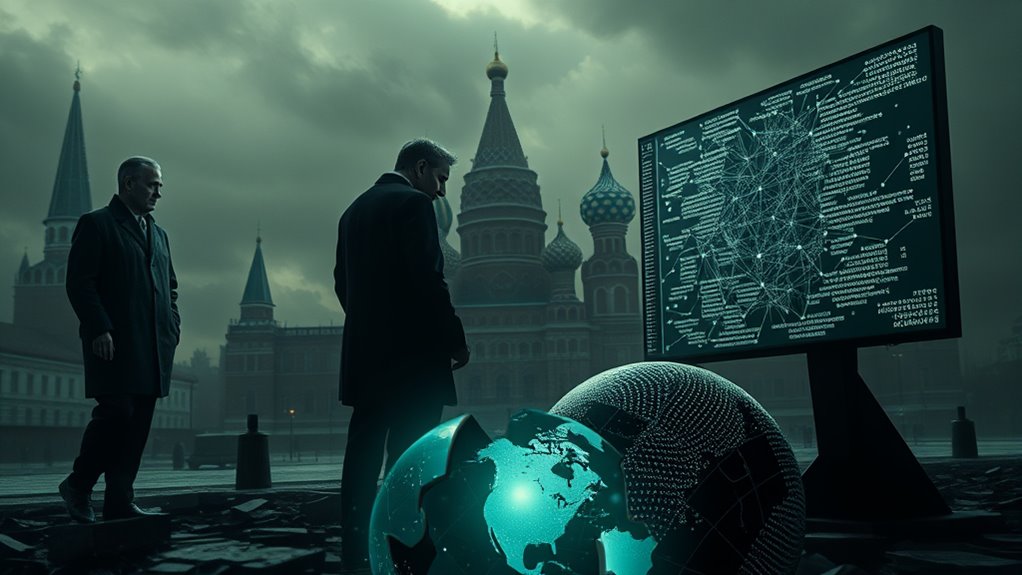
As you consider Russia’s vision for a multipolar world, think about how it contrasts with the U.S.-led unipolar order.
Russia’s concept of civilizational hierarchy reshapes its influence over smaller states, challenging traditional notions of sovereignty.
This shift not only reflects Moscow’s ambitions but also raises questions about the fairness of its approach in global politics.
Russia’s Civilizational Hierarchy Concept
While many nations pursue a unipolar world dominated by the West, Russia champions a multipolar world order, arguing it’s a fairer alternative. This civilizational hierarchy concept positions powerful states like Russia as leaders while lesser states fall under their spheres of influence. The Kremlin defends its actions, including military interventions, as necessary to maintain global balance against Western hegemony. However, its imperial behaviors raise questions about the legitimacy of this vision.
| Key Concepts | Russia’s Position | Implications |
|---|---|---|
| Civilizational Hierarchy | Advocates for leadership roles | Challenges equal sovereignty |
| Multipolar World Order | Promotes as a fair alternative | Resists Western dominance |
| Strategic Shift | Opposes Western values and influence | Aims for a balanced global order |
Multipolarity vs. Unipolarity Debate
The debate over multipolarity versus unipolarity has intensified as countries like Russia assert their vision for a new world order. The Kremlin promotes multipolarity as a fairer alternative to the U.S.-led unipolarity, envisioning a hierarchy where powerful states shape influence over smaller ones.
Russia’s military actions in Ukraine highlight its commitment to asserting dominance in its sphere of influence, raising questions about the legitimacy of this vision. As its foreign policy evolves, Russia seeks alliances with rising powers in the Global South and East, shifting away from Western partnerships.
This strategy reflects its desire to maintain stability and influence in contested regions, pushing against the unipolar framework while asserting its role as a key player in a multipolar landscape.
Influence on Smaller States
Russia’s push for a multipolar world order greatly impacts smaller states, as it seeks to reshape their geopolitical alignments. By positioning itself as a civilizational state, Russia uses its foreign policy to exert influence and create dependencies.
You might notice:
- Russia frames military interventions as protective measures against Western encroachment.
- It exploits the vulnerabilities of smaller states to assert control.
- The Kremlin promotes a hierarchy of sovereign states, justifying its actions in neighboring countries.
- This shift aims to coordinate relationships between Western and non-Western powers, particularly in the Global South and East.
Through these strategies, Russia aims to redefine global dynamics, presenting itself as a stabilizing force while raising concerns about its imperial ambitions.
Military Interventions: Lessons From Syria
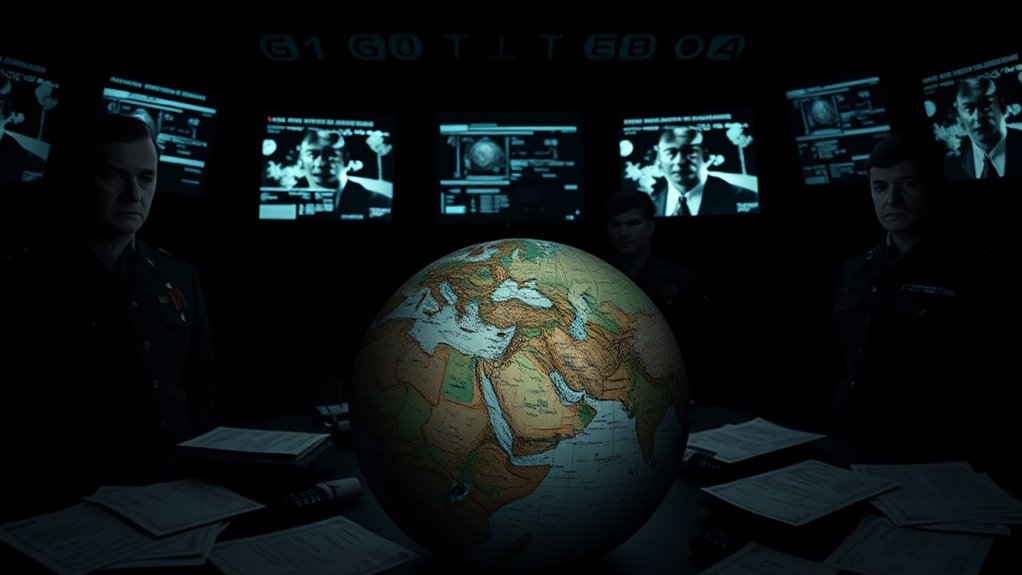
When you look at Russia’s military intervention in Syria, it’s clear that strategic engagements can reshape regional stability.
By positioning itself as a stabilizing force, Russia highlighted the importance of maintaining influence without large-scale military operations.
These lessons could inform future interventions and shift power dynamics in other regions.
Strategic Military Engagements
While many nations grapple with the complexities of military interventions, Russia’s experience in Syria offers valuable insights into strategic military engagements.
The Russian military’s intervention in Syria, aimed at preserving Bashar al-Assad’s regime, showcases a shift in foreign policy that emphasizes:
- Small-scale compromises over large-scale transformations
- A model of spheres of influence that contrasts with NATO membership dynamics
- The framing of itself as a stabilizing force in global affairs
- Increased demand for military aid and arms in other regions
This approach not only reflects Russian aggression but also positions Russia as a key player in global affairs, influencing other regions while learning from its Syria strategy.
Regional Stability Implications
Although military interventions often aim to restore order, the lessons from Syria reveal that Russia’s actions can have complex implications for regional stability. By positioning itself as a stabilizing force, Russia capitalized on U.S. failures, asserting influence among regional players. However, as the conflict in Ukraine strains resources, Moscow might shift from stabilizing efforts to embracing chaos.
| Russian Priorities | Implications for Regional Stability |
|---|---|
| Maintain spheres of influence | Increased military tensions |
| Support Assad regime | Potential for prolonged conflict |
| Engage with Iran, Turkey | Fragmentation of alliances |
| Shift focus to chaos | Erosion of security |
These dynamics illustrate how Russia’s military intervention in Syria shapes the broader landscape of regional stability.
Economic Strategies and Energy Dependencies

As Russia navigates the economic challenges of 2025, its strategies increasingly reflect a dependence on energy exports and external financial support.
The Russian economy faces significant hurdles, particularly due to military spending and sanctions. Key aspects of this situation include:
- Military spending accounts for nearly 30% of government expenditure, contributing to an inflation rate of 8.4%.
- The ruble’s depreciation highlights economic pressures, dropping to 104 against the US dollar.
- Labor shortages in the tech sector are stifling growth, as young professionals emigrate.
- Increased reliance on Middle Eastern support, especially from Saudi Arabia, aims to stabilize the economy amidst these challenges.
These dynamics underscore the critical nature of energy dependencies in shaping Russia’s future economic landscape.
Recruitment Challenges Within the Russian Military

The economic strains Russia faces due to military spending and sanctions have directly impacted its recruitment efforts within the military.
Recruitment challenges are evident, with the average age of new recruits in Moscow nearing 50. Despite financial incentives that promise pay exceeding ten times the average income, high casualty rates of around 120,000 Russian soldiers in Ukraine have led many to doubt the viability of these tactics.
Labor shortages continue to plague military operations, forcing the Kremlin to resort to deception and coercion to fill ranks.
In a desperate move, collaboration with North Korea has emerged as a tactic to bolster troop numbers, underscoring the extent of Russia’s recruitment struggles amid ongoing conflict.
Embracing Chaos: A New Foreign Policy Approach
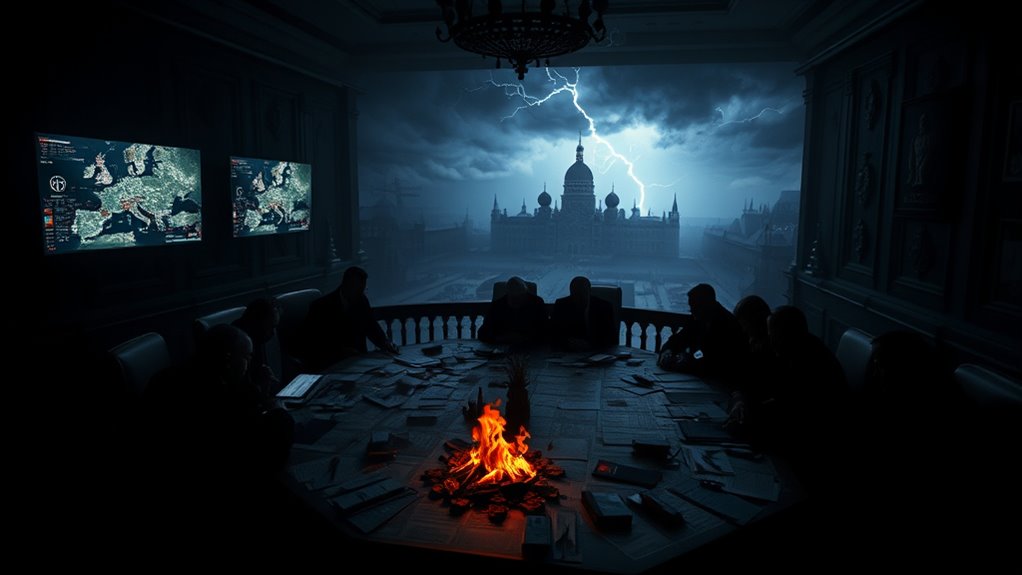
In a world where stability seems increasingly elusive, Russia is pivoting its foreign policy toward a strategy that embraces chaos. By stepping back from global stabilizing efforts, Moscow aims to leverage geopolitical turbulence for strategic flexibility. Here’s what you need to know:
- Russia’s foreign policy now favors transactional relationships with powers in the Global South.
- The leadership sees opportunities in instability, accepting suboptimal outcomes to retain influence.
- Analysts predict a G-Zero reality by 2025, marked by endemic geopolitical chaos.
- This shift reflects a departure from seeking recognition and cooperation with the West.
As Russia embraces chaos, it fundamentally reshapes its role in a fragmented international landscape, prioritizing influence over stability.
The Impact of Sanctions on Russia’s Economy

Russia’s embrace of chaos in its foreign policy comes with significant economic repercussions driven largely by international sanctions. With military spending consuming nearly 30% of government expenditure, the economy’s inflation rate has surged to 8.4%. The ruble has weakened dramatically, now at 104 against the US dollar, reflecting these pressures. Energy exports have plummeted from over 1.1 billion euros daily to just 611 million euros, highlighting sanctions’ impact.
| Economic Indicator | 2022 | 2024 |
|---|---|---|
| GDP Growth | – | 3.8% |
| Inflation Rate | – | 8.4% |
| Daily Energy Revenue | 1.1B euros | 611M euros |
Labor shortages, especially in tech, further complicate Russia’s ability to sustain military operations and its defense industry output.
Geopolitical Alliances and Rivalries
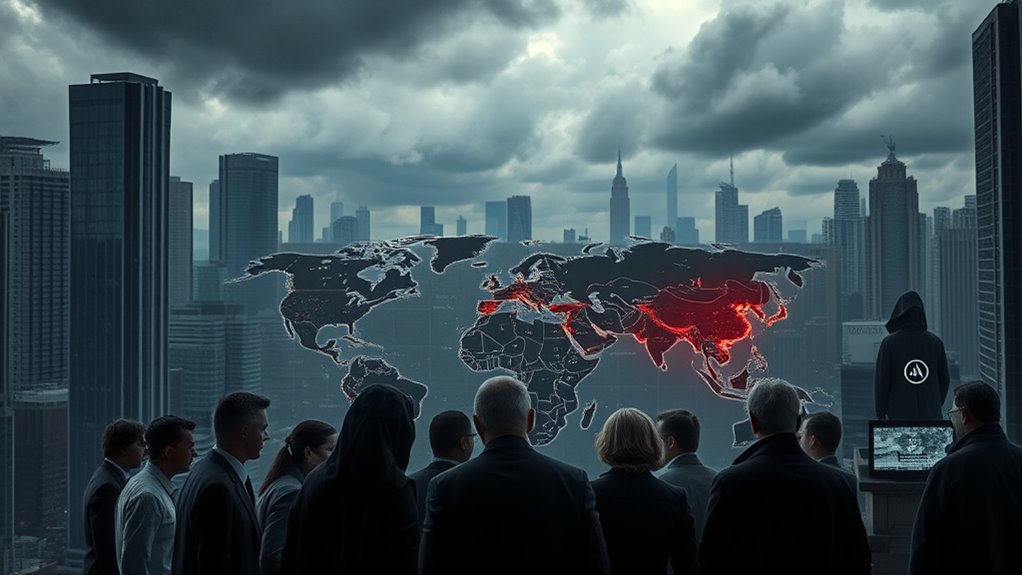
As geopolitical dynamics shift, Moscow seeks to reshape its role on the world stage by promoting a multipolar order that challenges U.S. dominance. By leveraging regional partnerships, Russia aims to assert its power and influence.
Key strategies include:
- Strengthening alliances with Iran, Turkey, and Saudi Arabia to stabilize energy prices
- Enhancing military cooperation and joint operations, particularly in Eastern Europe
- Expanding the BRICS coalition to include rising powers in the Global South
- Positioning itself as a stabilizing force in conflicts like Syria, contrasting with U.S. actions
These efforts come amid ongoing tensions from Russia’s invasion of Ukraine, which strain its ability to project power and maintain influence over allies.
This situation highlights the complexities of its geopolitical alliances and rivalries.
The Future of Russian Influence in Global Affairs
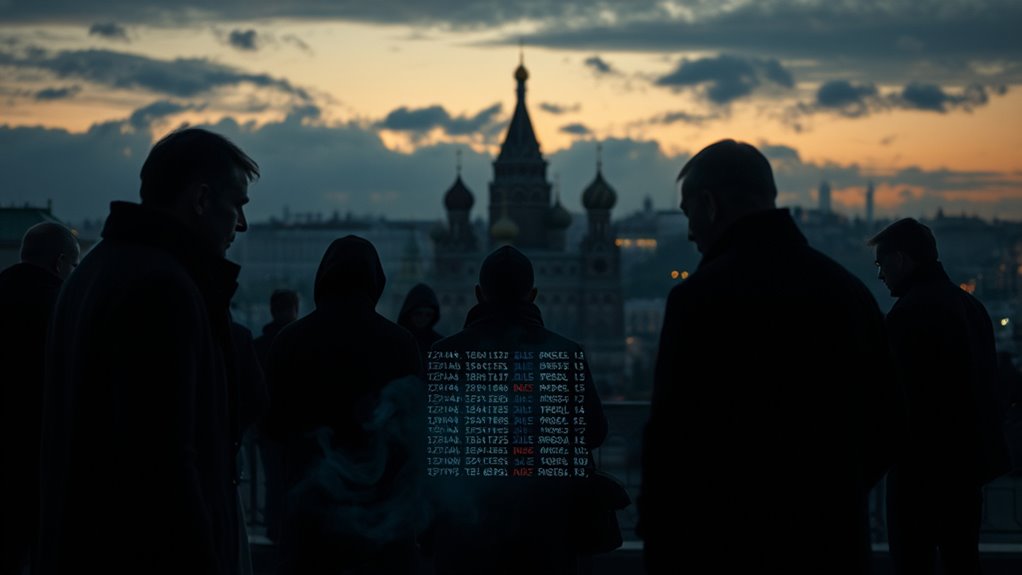
Moscow’s attempts to reshape its global influence are increasingly challenged by the fallout from its actions in Ukraine and the shifting dynamics of international relations.
As instability grows, Russia may resort to a chaos strategy to maintain relevance in a multipolar world. Its reliance on regional powers like Saudi Arabia and Turkey signifies a departure from its former role as a stabilizing force.
Through hybrid warfare and espionage, with over 160 incidents documented in 2024, Russia aims to disrupt Western unity while asserting itself as a power broker.
However, the collapse of the Assad regime and ongoing regional conflicts raise doubts about its legitimacy and effectiveness in influencing smaller states, complicating its geopolitical ambitions moving forward.
Frequently Asked Questions
What Are the Key Indicators of Russia’s 2025 Strategy?
To understand Russia’s 2025 strategy, you should focus on key indicators like military modernization, economic diversification, and regional influence.
Keep an eye on its technological advancements, especially in cybersecurity and energy sectors.
Additionally, monitor diplomatic maneuvers with neighboring countries and international allies.
Pay attention to internal developments, including public sentiment and political stability, as these will shape their long-term goals and actions on the global stage.
How Do Domestic Issues Affect Russia’s Foreign Policy?
When the home front’s on fire, can a nation ignore the flames?
Domestic issues greatly shape Russia’s foreign policy. Economic struggles, political unrest, and social discontent push leaders to rally national pride, often projecting strength abroad to distract from internal chaos.
You’ll see this reflected in military posturing and strategic alliances, as the Kremlin seeks to unify citizens by focusing on external threats, rather than addressing the pressing problems within its borders.
What Role Does Public Perception Play in Russia’S Geopolitical Maneuvers?
Public perception plays an essential role in shaping Russia’s geopolitical maneuvers.
You’ll notice that the government often adjusts its messaging to resonate with national pride and security concerns. When citizens perceive threats or challenges, the Kremlin uses that sentiment to rally support for its foreign policies.
Are There Historical Precedents for Russia’s Current Strategies?
Imagine a chessboard where each piece moves with intent, just like Russia’s current strategies.
Historically, you’ll find echoes of similar tactics—like during the Cold War, when Russia danced a careful ballet of misinformation and power plays.
You can see how these maneuvers shaped global perceptions and alliances.
How Do Russia’s Actions Influence Global Security Dynamics?
Russia’s actions considerably impact global security dynamics.
You’ll notice how its military maneuvers and diplomatic strategies create tensions and provoke responses from other nations.
By asserting influence in regions like Eastern Europe and the Middle East, Russia challenges existing power structures.
This can lead to arms races, alliances forming, and an overall climate of uncertainty.
Your understanding of these dynamics helps you grasp the complexities of international relations today and the potential risks involved.
Conclusion
In charting its 2025 ambitions, Russia’s strategies reveal a complex tapestry of chaos and calculated moves. Did you know that since 2014, Russia’s defense spending has surged by nearly 30%, reaching about $65 billion? This staggering investment highlights the urgency behind its military ambitions and global aspirations. As the world watches, the question remains: will Russia’s pursuit of power lead to a new era of influence or spiraling instability? The answer could reshape global dynamics for years to come.
